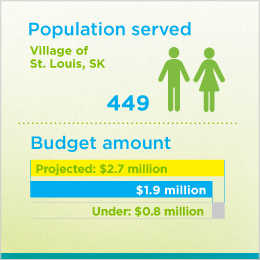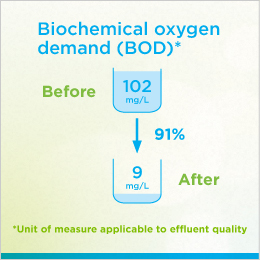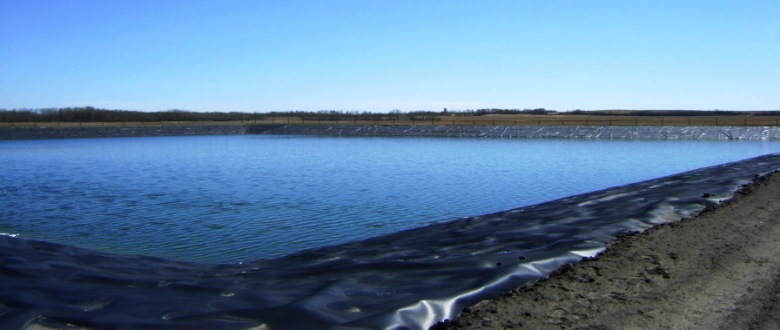This is part of a series of case studies on wastewater projects funded by the FCM's Green Municipal Fund. Each case study provides technical information, project details and tips on best practices.
Project overview
The Village of St. Louis, SK, upgraded its sewage collection and treatment system to comply with regulatory standards, improve water quality and support the community's growth and sustainability. The project team replaced the municipality's two gravity-fed septic tanks with a new facility, including a facultative lagoon, force mains to carry wastewater downstream from the discharge point, and two sewage pumping stations.



Reasons for the project
- The system was upgraded to ensure compliance with Section 16 of the 2002 Saskatchewan water regulations.
Innovative aspects of the project
- Biosolids are used as fertilizer for local farms.
Best practices and key lessons
The municipality's experience with this project demonstrates some best practices and key lessons that can inform similar projects.
Engage early and broadly
- A pre-project public meeting provided the opportunity for residents to give their opinions and feedback to municipal authorities. The village used public hearings and mail to keep residents informed.
Use effective communications and project management
- Extensive and proactive communication with partners allowed for efficient permit issuance, financing and other administrative processes.
- To avoid delays in the construction schedule, consider special environmental factors as well as surveying and purchasing land early.

View of facultative lagoon for St Louis, SK, wastewater treatment facility. (Credit: Village of St. Louis)
Project benefits
This project yielded a number of environmental, social and economic benefits.
Environmental benefits
- Improved effluent quality: The quality of the treated wastewater is expected to improve significantly (approximately 60 per cent) as a result of the new treatment process.
- Change in energy use and greenhouse gas emissions: The use of heavy trucks to dispose of sewage has been reduced. This reduction in energy use and GHG emissions is offset by the energy required for mechanical pumping at the new facultative sewage treatment lagoon. The net change has not been verified.
Social benefits
- Protection of public health: Improved wastewater quality positively impacts the health of residents.
- Increased opportunities for recreational activities: With reduced effluent discharge, residents adjacent to the South Saskatchewan River will be able to engage in recreational activities on the river and in the surrounding area.
- Increased public education: The project has increased public awareness of environmental and infrastructure issues.
- Enables community revitalization: In light of the increased capacity of the wastewater treatment system and the improved quality of treated wastewater, this project supports community growth and contributes to the overall sustainability of St. Louis.
Economic benefits
- Improved conditions for tourism: A cleaner waterfront increases the city's ability to attract tourists, who generate revenue for area businesses.
- Reduced maintenance costs: The new wastewater treatment system will require fewer repairs in the long term.
- Increased potential to attract new business: Since the new system can support new connections, St. Louis will now be able to support expansion of new or existing businesses and commercial entities.
- Increased potential to attract new residents: This project supports community growth and two new residential subdivisions have already been built.
- Local economic development: A new grocery store was able to open because of the increased capacity of the wastewater treatment system to support local businesses. This project indirectly led to new job creation.

Technical highlights
This project was a new facility. Technical highlights are current as of 2012.
Municipal population: 449
Urban/rural: rural
Treatment
- Before: Septic tank
- After: Facultative lagoon
Disinfection
- Before: None — N/A (With the previous septic tank system, no data was available.)
- After: None — 47 CFU/100 mL
Biosolids management:
- Before: Biosolids were collected and hauled for deposit as fertilizer material for area farms.
- After: Biosolids in the lagoon will be dredged approximately every 10 years and deposited as fertilizer material.
Annual average daily flow (AADF)
- Before: 0.16 MLD (million litres per day)
- After: 0.12 MLD
Design capacity
- Before: N/A
- After: 0.21 MLD
Per cent of total capacity used for AADF
- Before: N/A
- After: 76 per cent
Biochemical oxygen demand (BOD)
- Before: 65 mg/L
- After: 10 mg/L
Project contact information
Robin Boyer
Municipal Administrator
Village of St. Louis, SK
T. 306-422-8471
Want to explore all GMF-funded projects? Check out the Projects Database for a complete overview of funded projects and get inspired by municipalities of all sizes, across Canada.

